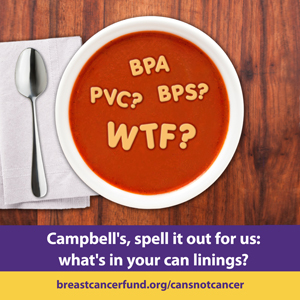 by Margie Kelly
by Margie Kelly
Communications Manager
www.healthychild.org
No longer is “BPA-free” enough.
Today we’re asking all our readers to head over to Campbell’s Soup’s Facebook page to ask the iconic American company what it plans to put in its cans instead of the toxic chemical bisphenol A (BPA).
Campbell’s recently announced its plan to eliminate BPA from its cans. What will America’s iconic soup company use instead? M’m M’m mum is the word.
We disagree with Campbell’s decision to withhold information from consumers. We have a right to know what’s in the products we buy.
BPA has been a hot topic in the media, in state legislatures, in grocery stores and mommy groups for a long enough time that babies who were newborns when the issue first hit the scene will start second grade in the fall.
News that a hormone-disrupting chemical that could hurt kids’ health was found in baby bottles created consumer outrage that led to swift changes. After all, 83 million moms with their two trillion dollars in purchasing power aren’t a group anyone can afford to alienate.
There are a few alternatives to BPA that aren’t any better for our health. BPS, a “chemical cousin” of BPA is not a safer alternative, though it certainly does not have the negative PR problems of BPA.
The notoriously bad plastic PVC is an FDA-approved alternative for BPA in can linings, despite the fact that vinyl chloride is a known human carcinogen.
.
Let’s be clear. None of us signed petitions, called manufacturers, sent letters to legislators, spread the word to friends about the dangers of BPA only to have manufacturers “solve” the problem by saying they were going “BPA-free” while switching to a chemical that was just as bad – or worse – for our health.
Healthy Child Healthy World is a proud member of the Cans Not Cancer campaign. The goal of this campaign is not merely about removing BPA from canned food. We also asked manufacturers to give us a timeline for their transition and to tell us about the alternatives they are using instead of BPA.
So today please help us out by using the power of social media to voice our displeasure at being stonewalled by Campbell’s. Ask them to be transparent about the materials they are using in their cans.
Here are sample tweets you can use on Twitter or Facebook. And be sure to look at the Healthy Child Healthy World Facebook page for updates! Please share this action with your friends and family!
- @CampbellSoupCo, spell it out for us: what’s in your can linings? #BPA #BPS? #PVC? #WTF! @CampbellCSR #CansNotCancer!
- Hey @CampbellSoupCo #BPA free is only good if the replacement is safe. We want #CansNotCancer! @CampbellCSR RT!
- #BPA free isn’t enough. RT if you want to know what’s in @CampbellSoupCo can linings! @CampbellCSR #CansNotCancer
The lining of a can is an integral part of how a can seals and is made safe for storage at room temperatures. It will probably take Campbell’s and other such canning companies time and many trials to find a can lining that will keep food safe at room temperatures and remove BPA. There is alot that goes into making sure a product is commercially sterile, the PH of the product, the type of seaming system, how it is cooked, what temperature it is cooked at, and yes the lining on the lid and can also play a role. Before getting all crazy at why this isn’t done yet, we should make sure we give the manufaturers enough time to find a safe, acceptable replacement. And not all replacements will be universally acceptable to all products.
Other companies, like Eden, have been using a BPA-free can for years. The technology already exists. It is more expensive.